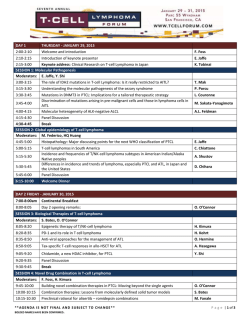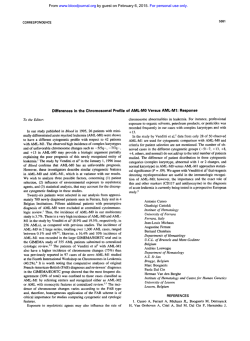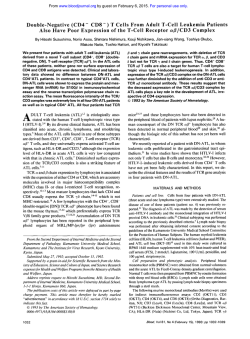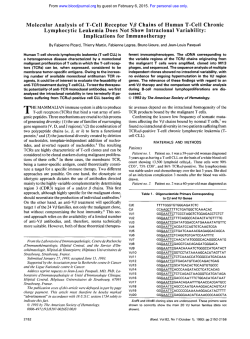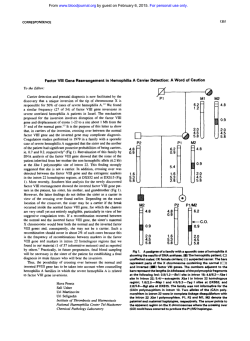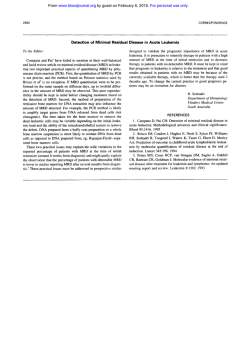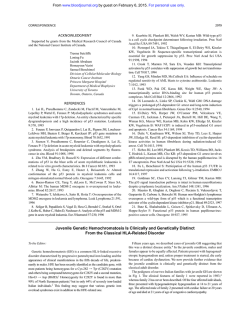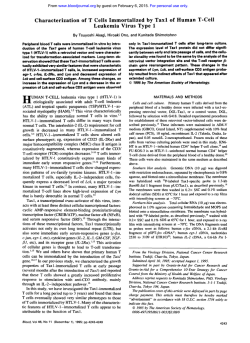
Constitutive Overexpression of the L-Selectin Gene in Fresh
From www.bloodjournal.org by guest on February 6, 2015. For personal use only. Constitutive Overexpression of the L-Selectin Gene in Fresh Leukemic Cells of Adult T-cell Leukemia That Can Be Transactivated by Human T-cell Lymphotropic Virus Type 1 Tax By Makoto Tatewaki, Kazunari Yamaguchi, Masao Matsuoka, Toshinori Ishii, Masayuki Miyasaka, Shigeo Mori, Kiyoshi Takatsuki, and Toshiki Watanabe L-selectin is an adhesion molecule of the selectin family that mediates the initial step of leukocyte adhesion t o vascular endothelium. Upon cellular activation, expression of the Lselectin gene is downregulated at both the protein and mRNA levels. To understand the mechanism of leukemic cell infiltration into organs, we studied the expression and regulation of L-selectin mRNA in fresh leukemic cells of adult T-cell leukemia (ATL) patients and investigatedthe response of theL-selectin promoter t o human T-cell lymphotropic virus type1(HTLV-1)Tax, which isa viral transcriptional transactivator. Flow cytometry showed that L-selectin was expressed onfresh ATL cells along with otheractivation antigens. Northern blotanalysis showed that ATL cells overexpressed the L-selectin mRNA and that the level was aberrantly upregulated after PMA stimulation. Studies using in situ hybridizationshowed expression of the L-selectin mRNA in the infiltrating leukemic cells in the liver of two ATL patients. Intravenous injection of a rat T-cell line that overexpresses L-selectin showed increased organ infiltration. The induction ofTax expression in JPX9 cells resulted in about a twofold increase in the mRNA expression levels compared with the basal level. Chloramphenicol acetyltransferase(CAT)assay after transient cotransfection showed about a fivefold transactivation of the L-selectin promoter by Tax. The serum level of the shed form of L-selectin was significantly increased in ATL patients (mean f SD, 4,215.4 f 4,111 ng/mL) compared with those of asymptomatic carriers and healthy blood donors (mean f SD, 1.148.0 & 269.0 ng/ mL and 991.9 f 224 ng/mL, respectively). These results indicated that ATL cells constitutively overexpress the L-selectin gene that can be transactivated by HTLV-1 Tax. The overexpression of L-selectin, aswell as of inflammatory cytokines, by ATL cells may provide a basis for ATL cells t o attach the vascular endothelium, leading t o transmigration and organ infitration. 0 1995 by The American Societyof Hematology. A from the cell surface by shedding16 and transcription of the mRNA is also downregulated by18 to 24 hours.L7318 This downregulation is thought to prepare the extravasated cells for transmigration into tissues. The extracellular domain is proteolytically shed from the cell surface” and the shed form of L-selectin (sL-selectin) is present at a relatively high concentration in the normalserum, in which it is functionally active, inhibiting leukocyte attachment to the endothelium at high concentrations.20Thus, the regulation of L-selectin expression at the transcriptional level as well as in protein processing appears to be an important determinant of physiologic and pathologic manifestations of the function of this adhesion molecule. HTLV- 1 has a transcriptional activator, Tax, that regulates viral replication at the transcriptional level.21Transactivation of the viral genes by Tax is mediated through three repeats of a 21-bp enhancer in the long terminal repeat (LTR).22 Because Tax cannot directly bind to the enhancer sequence, the cellular transcription factors are thought to mediate the DULT T-CELL LEUKEMIA (ATL) is an aggressive, usually fatal T-cell malignancy that is caused by human T-cell lymphotropic virus type 1 (HTLV-1) ATL is also characterized by unique clinical features such as a very high frequency of hypercalcemia anda remarkable tendencyoforgan infiltration by leukemiccellsintotheliver, spleen,lungs,and ~ k i n . 4 ,HTLV-1 ~ isalsoassociated with chronic inflammatory disorders such as tropical spastic paraparesis /HTLV-1 -associated myelopathy (TSPMAM), HTLV-l uveitis (W),alveolitis, and others!-” Infiltration of mononuclear cells and HTLV-1 -infected T cells is alsoa characteristic commonly found in these HTLV-l-associated diseases. Spinal cord lesions of patients with TSP/HAM are characterized by demyelinationaccompanied by mononuclearcellinfiltration and perivascularcuffing.12 Inthe aqueous humor of the patients with HU, the infiltrating cells consisted mostly of lymphocytes with a predominance of T cells and theHTLV-1-infected cells were aimost universally present among Thus, the infiltration of lymphocytes in various organs could be one of thecommonpathologicfindingsamongdiseasesassociated with HTLV-1 infection. L-selectin is a member of the selectin family of adhesion molecule^.^^ It is expressed on the surface of most leukocytes, including lymphocytes, neutrophils, monocytes, eosinophils, hematopoietic progenitor cells, and immature thymocytes. L-selectin is a highly glycosylated protein of 95 to 105 kD on neutrophils and of 74 kD on lymphocytes. It is thought to mediate lymphocyte recirculation to the peripheral lymph node, specifically recognizing high endothelial venules in lymph nodes. In addition, L-selectin is involved in the adhesion of neutrophils, monocytes, and lymphocytes to activated endothelium at sites of inflammation. Extravasation of circulating lymphocytes consists of three steps? rolling mediated by selectins, sticking .by integrins, and transendothelial migration. L-selectin is considered to mediate the initial attachment of lymphocytes to endothelium, which determines the stickiness of the cells. After cellular activation, this molecule rapidly disappears B/ood, Vol86, No 8 (October 15). 1995 pp 3109-3117 From the Department of Pathology, The Institute of Medical Science, The University of Tokyo, Tokyo; theSecond Department of Internal Medicine, Kumamoto University School ofMedicine, Kumamoto: andthe Division of Organ Bioregulation, Biomedical Research Center, Osaka University Medical School, Osaka, Japan. Submitted December 30, 1994: accepted June S, 1995. Supported in part by a Grant in Aid for ScientGc Research to T.W. and a Grant in Aid for Cancer Research to T. W.and K. Y. from the Ministry of Education, Science and Culture, Japan. Address reprint requests to Toshiki Watanabe, MD, PhD, Department of Pathology, The Institute of Medical Science, The University of Tokyo, 4-6-1 Shirokanedai, Minatoku, Tokyo 108, Japan. The publication costs of this article were defrayed in part by page charge payment. This article must therefore be hereby marked “advertisement” in accordance with 18 U.S.C. section I734 solely to indicate this fact. 0 1995 by The American Society of Hematology. 0006-4971/95/8608-0007$3.00/0 3109 From www.bloodjournal.org by guest on February 6, 2015. For personal use only. 31 10 TATEWAKI ETAL transa~tivation?~.~~ In addition to the viral genes, Tax induces the expression of the cellular transcription factor genes25that are controlled by transmembrane signals and also some genes that encode cytokines and their rece~tors.*~-*~ Some of the genes that can be transactivated by Tax are constitutively expressed in ATL cells that modulate clinical ATL cells have a membrane phenotype ofactivated CD4+ T cells, expressing interleukin-2 receptor (Y (LL-2Ra), HLADR, and other activated cell antigen^.^',^' The data of Ishikawa et al. suggested that ATL cells are characterized as CD4+Leu-8’ T cells?2 Because Leu-8 antigen is identical to L-selectin, ATL cells express typical activation antigens and L-selectin at the same time, which suggests that the regulation of L-selectin expression is aberrant. We studied the expression of L-selectin in ATL cells and tested the regulation of its gene expression by HTLV-1 Tax, which would provide a clue to understanding the molecular mechanism of L-selectin gene expression and leukemic cell infiltration into various organs in ATL patients. MATERIALS AND METHODS Patientsplasma and cell samples. ATL was diagnosed according to the described criteria? Briefly, a T-lymphocyte neoplasm that resulted from the monoclonal expansion of HTLV-l-infected T cells was diagnosed as ATL. Seropositivity against HTLV-l was tested using a PA kit (Fujirebio, Tokyo, Japan) and confirmed using an enzyme immunoassay (HA) kit (Eizai, Tokyo, Japan). The integration of HTLV-l provirus DNA was studied using Southern blottir~g.~’ Peripheral blood mononuclear cells (PBMCs) from patients with ATL and normal blood donors were isolated by density gradient centrifugation with Ficoll Paque (Pharmacia, Uppsala, Sweden). RNA was immediately extracted from the cells or they were quickly frozen in liquid nitrogen and stored at -80°C until use. Plasma samples were collected at the time of PBMC preparation and stored at -80°C until use. Cell lines. Jurkat is a human T-cell line established from T-ALL cells and JPX-9 is a derivative of Jurkat cells carrying the transfected Tax gene under the control of metallothionein promoter.34MT-1 is a human T-cell line derived from leukemic cells of an ATL patient.35 These cells were cultured in RPM11640 supplemented with10% fetal bovine serum and antibiotics. FL cells were derived from human amnion cells36and maintained in Dulbecco’s modified Eagle’s medium supplemented with 5% fetal bovine serum and antibiotics. The expression of Tax in JPX9 cells was induced by adding 20 pmol/L CdClz into the medium. Immunophenotyping. Cell surface markers of leukemic cells from 20 patients with ATL (13 with acute type and 7 with chronic type) were studied and those of normal T cells from 9 blood donors served as controls. Heparinized whole blood samples were immunophenotyped without PBMC isolation. Cell surface antigens were detected by standard immunofluorescence using a panel of directly fluorescein isothiocyanate (FlTC)- or phycoerythrin-conjugated monoclonal antibodies. The expression of surface antigens was studied by means of double immunofluorescence using antibodies that react with CD3, CD4, CD8, CD25, and Leu-8 (Becton Dickinson, San Jose, CA; Coulter, Hialeath, FL). Double immunofluorescence was performed using a Spectrum 111 flow cytometer (Ortho, Westwood, MA). A total of more than 5,000 cells were analyzed for each sample. Immunohistochemical analysis of the formalin-fixed and paraffinembedded tissues was performed using SAB rneth~d.’~ Analysis of L-selectin gene expression. Total cytoplasmic RNA was extracted from the fresh PBMCs of ATL patients and cell lines using the vanadyl ribonucleoside complex.38To study the modulation of gene expression, PBMC samples were cultured for 18 to 24 hours with or without phorbol myristate acetate (PMA; 10 ng/mL)and then cytoplasmic RNA was extracted. Ten micrograms of total RNA was Northern blotted. After transfer to nylon membranes (BioDyne B; Pall BioSupport COT, Glen Cove, NY), the RNA was fixed by UV irradiation. The membrane was hybridized with probes at 42°C in a solution containing 50% formamide, 4X SSC, lox Denhardt’s solution, 0.1% sodium dodecyl sulfate (SDS), and 100 pglmL of denatured salmon sperm DNA. An L-selectin cDNA probe covering entire protein coding sequence was prepared using reverse transcription-polymerase chain reaction (RT-PCR) and cloning into the pCRIl plasmid by means of TA cloning (In Vitrogen, San Diego, CA). The nucleotide sequence of the insert cDNA was confirmed by sequencing using the Sequenase kit (US Biochemicals, Cleaveland, OH). For detection of L-selectin mRNAin tissue samples, we performed in situ hybridization. Samples of the formalin-fixed and paraffin-embedded liver of two ATL patients and a biopsy specimen of a patient with chronic active hepatitis were used for the study. Serial sections of 4 to 6 pm were prepared on the slides coated with 3aminopropyltriethoxysilane. Digoxigenin-labeled antisense and sense L-selectin cRNA probes were prepared from a plasmid containing 589bp cDNA fragment (nucleotide position 998-1586)17using DIG RNA Labelling Kit (Boehringer Mannheim Biochemica, Mannheim, Germany). Hybridization was performed at 37°C for 12 hours in a solution containing 50% deionized formamide, 10 mmoll L Tris HCI, pH 7.6, 10% dextran sulfate, 1 X Denhardt’s solution, 600 mmollL NaCI, 1 mmollL EDTA, 1% SDS, and 200 ng/mL DIGlabeled cRNA probe. After hybridization, the slides wererinsed twice in a solution containing 2X SSC and 0.1% SDS at room temperature for 5 minutes and once in a solution containing 0 . 2 ~ SSC and 0.1% SDS at room temperature for 5 minutes. Detection of the hybridization was performed using DIG Nucleic Acid Detection Kit(Boehringer Mannheim Biochemica) according to the manufacturer’s instructions. Analysis of organ injiltrution by an L-selectin-overexressing rut T-cell line. An expression vector for the rat L-selectin was constructed using BCMGSNeo and an HTLV-lhnfected rat T-cell line TARL-2,“‘ which does not express L-selectin, was transformed and selected by neomycin. Expression of L-selectin by the transformed cell line was confirmed by Nothem blotting and flow cytometry (data not shown). About 1 X 10’ cells of the L-selectinoverexpressing TARL-2 [TARL-2 L(+)] and the original cell line were labeled by FITP’ and injected into WKAH rat intravenously. Two hours after injection, an immunohistichemical study was performed using anti-FITC antibody (DAKOPAITS AIS, Glostrup, Denmark) and SAB method.37 Plasmid, transfections, and chloramphenicol acetyltransferase (CAT) assays. L-selectin promoter-CAT plasmid, pLS-I CAT, has a genomic fragment of about 900-bp that flanks the 5’ end of exon 2 of the L-selectin gene.4’ The L-selectin promoter has been identified and characterized (Tatewaki et al, submitted for publication). Transcriptional transactivation was tested by transient cotransfection assays using a Tax expression plasmid.26FL and Jurkat cells were transfected using CaPO, precipitation and diethyl aminoethyl (DEAE)-dextran, respectively.4 About 1 X IO7 cells of each type were transfected with 10 pg of CAT reporter plasmids, together with 2 pg of the Tax expression vector. After 48 hours, cells were harvested and extracts were assayed for CAT activity according to the method of Gorman et except the radioactivity was measured by Bio lmage Analyzer, BA100 (Fuji, Tokyo, Japan). The pp-Gal plasmid was cotransfected to monitor the efficiency of transfection and CAT activity was corrected by the activity of p-Gal in each experiment. Quantitation of the serum level of sL-selectin and sIL-2Ra. Serum levels of the shed form L-selectin (sL-selectin) were quantified From www.bloodjournal.org by guest on February 6, 2015. For personal use only. OVEREXPRESSION OF L-SELECTIN IN ATL 3111 Table 1. Leu4 Expression in the Peripheral Blood of ATL Patients and Normal Controls Case No. 1 2 3 4 5 6 7 8 9 10 11 12 13 14 15 16 17 18 19 20 21 22 23 24 25 26 27 28 29 Type CD4' Leu8' Acute 24.8 92.6 Acute 75.9 86.4 Acute 63.8 73.6 Acute 44.9 80.2 Acute 47.1 89.6 Acute 57.6 96.5 Acute 55.9 64.1 Acute 78.5 95.6 Acute 65.6 97.7 Acute 53.3 86.4 Acute 86.9 94.4 Acute 73.8 77.2 Acute 51.7 84.2 Chronic 84.3 91.o Chronic 90.3 92.3 Chronic 84.1 94.6 Chronic 62.8 66.0 Chronic 87.0 96.4 Chronic 59.2 71.6 Chronic 97.2 Control 43.6 48.3 Control 41.0 46.4 Control 31.1 37.8 Control 43.3 47.1 Control 30.9 Control 39.4 47.1 Control 33.4 32.0 Control 37.6 ND Control 33.8 ND 17.7' 68.1' 85.0' 57.9' 69.3* 44.9' 68.8' 63.6' 53.4' 1.8' 84.8' 77.6' 54.0' 85.1' 4.8 82.5' 69.9' 79.4* 63.5' 88.7' 70.1 81.2 70.7 79.1 69.5 70.4 65.5 73.8 54.0 * 100% I . Leu-8'1CD4' 20 I n 0 0 I I ATL Control ND Fig 1. The ratio of Leu&positive cells among CD4+ cells in the peripheral blood ofATL patients and normal controls. The percentages in ATL patients are significantly higher than those of normal controls (Mann-Whitney U test). 'P = .0002. 25.1 The percentages of positive cells for each antigen are shown. Abbreviations: CD4', Leu-8*, percentages of cells positive for respective antigen among lymphocytes; Leu-8'/CD4', percentage of Leu-8-positive cells among CD4' cells;acute, acute-type ATL; chronic, chronic-type ATL; control, control samples collected from normal volunteers; ND, not determined. MFI of positive cells was lower than that of controlcells. using an sL-selectin enzyme-linked immunosorbent assay (ELISA) kit (Bender MedSystems, Vienna, Austria) and those o f the soluble form of IL-2Ra (sL2Ra) were quantified with an sIL-2Ra ELISA kit (Tcell Diagnostics, Cambridge, MA), according to the manufacturer's instructions. The plasma or serum samples numbered 29 from A T L patients, 10 from asymptomatic carriers, and 10 from seronegative control individuals. Among the samples f r o m A T L patients, PBMCs from 5 were included in the analysis o f L-selectin mRNA expression using Nothem hybridization. RESULTS The surface expression of L-selectin on ATL cells. Flow cytometry showed that the percentage of L-selectin-positive cells among those that were CD4+ was 65.7% 2 17.6% (mean 2 SD) in ATL patients, whereas that of the normal control was 36.5% t 6.15% (mean 2 SD; Table 1). The results of the flow cytometry are summarized in Fig 1. The population of Leu-8-positive cells among the CD4+ cells that almost represents the entire leukemic cell population was significantly high in ATL patients (P= .0002 by MannWhitney U test). L-selectin rnRNA expression in ATL cells. Northern blot- ting showed that normal PBMCs expressed L-selectin transcripts at a relatively high level and that the PBMCs of ATL patients, which consisted of mainly ATL cells, expressed it at much higher levels (Fig 2). These results were confirmed in all 8 patients with ATL that were studied. We then tested the modulation of gene expression of L-selectin by activating the cells in vitro. The level of L-selectin expression in the ATL cells was upregulated after 18 to 24 hours of stimulation with PMA, whereas the normal PBMCs were downregulated (Fig 3). All of the three HTLV-l viral transcripts, ie, genomic, env, and pX, were detected after stimulation, whereas they were not expressed in fresh leukemic cells at a detectable level (Fig 3). Thus, fresh primary ATL cells constitu- 1 L-selectin 2 3 4 4 18s ribosomal RNA Fig 2. Expression of L-selectin mRNA in fresh PBMCs of ATL patients. Ten micrograms of total RNA sample was applied t o each lane. Lane 1, normal freshPBMC RNA; lanes 2 through 4, PBMC RNA samples from patients with acute ATL. From www.bloodjournal.org by guest on February 6, 2015. For personal use only. 3112 TATEWAKI ET AL 1 Lselectin 2 3 4 induction The of L-selectin gene expression byinTax JPX-9cells. To examine the effect of Tax on the L-selectin 4 18s HTLV-1 ribosomal RNA Fig 3. Aberrant regulation of L-selectin mRNA expression and the induction of HTLV-1 viral mRNA by PMA stimulation. Lanes 1 and 2, fresh (1) and PMA-stimulated (2) PBMC samples from a normal control; lanes 3 and 4, fresh (31 and PMA-stimulated (4) PBMC samples from a patient with acute ATL L-selectin mRNA expression was upregulated after PMA stimulation in ATL cells. HTLV-1 viral mRNA was also induced by PMA stimulation of ATL cells. tively overexpressed L-selectin mRNA in the absence of viral gene expression, which was further upregulated after PMA stimulation. The correlation between viral gene expression including pX mRNA and upregulation of L-selectin gene expression suggested that the viral transactivator, Tax that is encoded by pX mRNA, is involved in the induction of L-selectin gene expression, as it is with other cellular genes. The expression of L-selectin mRNA in the infiltrating leukemic cells was studied using in situ hybridization of the liver samples of two ATL patients that show perivascular infiltration of ATL cells. A liver biopsy specimen of a chronic hepatitis patient served as a control. Serial sections of the liver were hybridized with DIG-labeled antisense (Fig 4A) or sense (Fig 4B) L-selectin cRNA probe. Hybridization signals for L-selectin mRNA were detected in infiltrating mononuclear cells in Glisson's sheath of the liver (Fig 4A) only when the antisense cRNA probe was used. Immunohistochemical staining withUCHL-l monoclonal antibody showed that most of the infiltrating cells were T cells (Fig 4C). Almost no hybridization for L-selectin mRNA was detected in the infiltrating lymphocytes in the biopsy specimen of a chronic active hepatitis patient (data not shown). Organ infiltration of a rat T-cell line that overexpresses L-selectin. As shown in Fig 5 , many FITC-labeled cells were detected immunohistochemically in Glisson's sheath of the liver when TARL-2 (L+) cells were injected, whereas only a few were detected when the original cells were used. Effcient FITC labeling of both cells was confirmed by detection of the injected cells in the lung in which these two cells did not show a marked difference in the number of trapped cells (data not shown). gene expression, we used JPX-9 cells that have an inducible Tax gene. We studied the time course of the expression of L-selectin and Tax by means of Northern blotting. CdClz added to the culture medium induced Tax gene expression in JPX-9 cells within 1.5 hours.% Although L-selectin gene is constitutively expressed in JPX-9 cells at a relatively high level, the expression started to increase along with the induction of Tax expression. It showed a small peak at 2 hours, a small decrease at 6 hours, and then a continuous increase until 33 hours, reaching about double the basal level (Fig 6). CdCl2 did not influence the level of L-selectin gene expression in the parental Jurkat cells (data not shown). Thus, the results suggested that Tax increased the transcription of the L-selectin gene and that endogenous cellular factors are involved in the induction. The L-selectin promoter is transactivated by HTLV-1 Tax. To examine whether the L-selectin promoter, which we identified (Tatewaki et al, submitted for publication), responds to Tax, we assayed CAT by means of transient cotransfection with the Tax expression vector. The reporter plasmid, pLS1 CAT, has the L-selectin promoter fragment up to -885. The promoter was activated by Tax both in Jurkat and FL cell lines. Representative results are shown in Fig 7. The magnitude of transactivation by Tax was about fivefold in FL cells and a little less in Jurkat cells. To identify the Tax-responsive element(s), we prepared CAT reporter plasmids with a serially deleted promoter sequence and tested the response to Tax. However, the levels of transactivation were gradually decreased with deletion and no specific region that affected the response was identified (data not shown). These results suggested that multiple elements in the promoter are involved in the transactivation by Tax. Elevated serum levels of sL-selectin in ATL patients. To examine the overexpression of L-selectin by ATL cells in vivo, we measured the level of sL-selectin in the sera of 29 ATL patients, 10 asymptomatic carriers, and 10 normal blood donors. We also measured the serum level of IL-2Ra. which is a good marker of leukemic cell mass in vivo.* The mean level of sL-selectin in 29 patients with ATL was significantly increased (mean t SD, 4,215.4 ? 4,111 ng/ mL) compared with those in asymptomatic carriers and normal blood donors (mean ? SD, 1,148.0 ? 269 ng/mL and 991.9 2 224 ng/mL, respectively; Fig 8). We studied the correlation between sL-selectin and sIL-2Ra in samples from 25 patients with ATL. As shown in Fig 9, the level of sL-selectin correlated well with that of sIL-2Ra ( y = 0.6). suggesting that the serum level of sL-selectin depends on the leukemic cell mass. These results provided more evidence that L-selectin is overexpressed by ATL cells in vivo. DISCUSSION The adhesion properties of peripheral blood leukemic cells from 10 patients with ATL have been characterized by Ishikawa et aI?* They showed that E-selectin and vascular cell adhesion molecule-l (VCAM-1) mediate ATL cell adhesion to endothelial cells. However, the counter-receptors on ATL cells for E-selectin and VCA"1 remained to be determined. From www.bloodjournal.org by guest on February 6, 2015. For personal use only. OVEREXPRESSION OF L-SELECTIN IN ATL 3113 Fig 4. Expression of L-selectin mRNA in the infitrating ATL cells in theliver. (A and B) Hybridizationwith antisense and sense probes for Laalectin, respectively. (C) Immunohistochemical daection of T dlr using UCHL-1 monoclonalantibody. Adhesion molcules expressed on ATL cells have not been well characterized. Fukudome et a14’ reported that intercellular adhesion molecule-l (ICAM-1) expression was highly induced in human T cells transformed by HTLV-l and fresh ATL cells. However, it is not known whether they are involved in organ infiltration of ATL cells. Thus, further characterization of adhesion molecules expressed on ATL cells should help understand the mechanism underlying organ infiltration. Fig 5. Infiltration inthe liver by an L-selectin overexpressing T-cell line, TARL-2 L(+), after intravenous injection. The liver from a rat injected with TARL-2 L(+) is indicated as L(+) and that injected with the original TARL-2 as L(-) (lower left).A control reaction without anti-MTC antibody using the liver of a rat injected with TARL-2 L(+) is indicated as PBS (upper left). We showed that the L-selectin gene is constitutively overexpressed in ATL cells and that the viral transactivator Tax can induce its expression. We also showed that the serum levels of sL-selectin in ATL patients were significantly elevated and that they correlated well with those of sIL-2Ra. These results indicated that the constitutive overexpression of L-selectin is one of the characteristic phenotypes of ATL cells. Our flow cytometric study of surface markers of ATL From www.bloodjournal.org by guest on February 6, 2015. For personal use only. TATEWAKI ET AL 3114 A time (h) 0 2 4 11 18 33 B n L-Selectin HTLV-1 Tax GAPDH 0 2 4 11 18 33time ( h ) Fig 6. Induction of L-selectin mRNA expression after the expression of HTLV-1 Tax in JPX9 cells. (A) Resutts of Northern blot hybridization. g RNA were subjected for formalin-agarose gel electrophoresis. (B) The relative intensities of the hybridization signals. Samples of l 0 p total Measured radioactivity was corrected using that of GAPDH. cells cleary showed that they expressed Leu-8 antigen (Table 1 and Fig 1). The mean fluorescence intensity (MFI) of positive cells was generally low in ATL cells compared with that of normal controls. Considering the constitutive overexpression of mRNA shown in this study, low MFI may suggest a rapid turnover of the protein. In line with this notion, other investigatcrs have reported variable levels of L-selectin expression on ATL cells.3z It has been reported that L-selectin surface expression is downregulated by various leukocyte isolation procedures?' which may explain some inconsistency in the data reported by different groups. Therefore, to characterize the L-selectin expression, mRNA expression should be studied by such means as Northern blotting in addition to flow cytometry and immunocytochemistry. The results of our Northern blot analysis showed a rather constant and high level of mRNA expression in ATL samples (Fig 2), which is consistent with the results of our flow cytometric analysis. In addition, demonstration of Lselectin mRNA in the infiltrating cells in the liver of ATL patients (Fig 4), but not in the liver with inflammatory infiltration of lymphocytes, appears to provide more evidence for abnormal regulation of gene expression, because it was reported that L-selectin expression was downregulated after e~travasation.4~ Subsets of CD4+ T cells that showed enhanced transendothelia1 migration were identified as CD29'nEh', CD45RObngh1, and CD45RA-.50 These phenotypes are similar to those of ATL cells." In addition to this, the overexpression of Lselectin may render ATL cells more sticky to vascular endothelial cells than normal T cells. Furthermore, ATL and HTLV- 1 -infected cells produce various inflammatory cytokine^.^^"^ These phenotypic characteristics of ATL cells would enable them to activate vascular endothelial cells to express adhesion molecules and to attach themselves firmly to activated endothelium. The notion that overexpression of L-selectin itself can affect the lymphocyte recirculation seems to be partly supported by our observation that a rat T-cell line that overexpresses L-selectin showed an increased A c 0 .-2 a 2 S $ 4 3 2 1 0 Tax Tax (+) (-) Fig 7. Transactivation of the L-selectin gene promoter by HTLV-1 Tax. Representative results of a CAT assayafter the cotransfectionof pLS-1 CATand a Tax expression vector in FL cells (A). The percentage ofconversionofchloramphenicol that iscorrected by the P-Gal activity is shown in (B). The CAT activity was transactivatedabout fivefold in the presTax.of ence From www.bloodjournal.org by guest on February 6, 2015. For personal use only. 3115 OVEREXPRESSiON OF L-SELECTIN IN ATL Q8 * I F * I n I 01 ATL AC Cont. Fig 8. Elevated serum levels of sL-selectin in ATL patients. Plasma levels of sl-selectin in 29 ATL patients, l 0 asymptomatic carriers (AC), and10 normal blood donors(Cont.)were plotted. Bars indicate the mean f SD. *P < .05 using the Student's t-test. level of organ infiltration when injected into a rat intravenously (Fig 5). However, Schleiffenbaum et alzo have shown that the increased levels of sL-selectin in the medium inhibited the interaction between L-selectin and its ligands. Therefore, it appears more likely that, even though ATL cells might have enhanced capacity to adhere to and transmigrate the endothelial cells, organ infiltration is determined by the dynamic balance in vivo between the increased stickiness of ATL cells and the inhibitory effect of sL-selectin in the serum. Thus, to understand the biologic significance of the L-selectin overexpression, the correlation between the serum levels of sL-selectin and the clinical manifestation of organ infiltration in ATL patients of each clinical subtype should be further studied, and the gene expression of other adhesion molecules as well as inflammatory cytokines should be characterized. As mentioned before, HTLV- 1 Tax induces expression of cytokines, growth factors, and their receptor^.^^ IL-2Ra and parathyroid hormone-related protein (FWIrP) are examples of these genes, and they are constitutively overexpressed in ATL ~ e l l sThe . ~overexpression ~ ~ ~ ~ of cellular genes that can be transactivated by Tax is one of the common features of ATL cells. The L-selectin gene appears to be the first example of adhesion molecules with this characteristic. The level of transactivation of the L-selectin promoter induced by Tax was about fivefold in repeated experiments, which is lower than that of reported cellular genes. This difference could be explained by the relatively high level of background activity of L-selectin promoter both in Jurkat cells and FL cells (Fig 6 ) .Similar observations were recently reported by Ohbo et a15' on the IL-2Ry chain gene expression that was transactivated by HTLV-1 Tax. It may also be due to the difference in the molecular mechanism underlying the transactivation. It has been shown that HTLV-1 Tax transactivates gene expression through interactions with cellular transcription factors such as CREBP, NF-KB, and No consensus sequence elements for these factors were found in the L-selectin promoter up to -885 bp. Instead, there are multiple sequence elements for Ets family oncogenes (Tatewaki et al, submitted for publication), which reportedly participate in the transactivation of HTLV-1 LTR and the promoter of the F'THrP Functional characterization is now under way to answer whether these characteristics of the L-selectin promoter could explain the apparent difference in the response to Tax. In all the ATL samples that we have so far examined, viral mRNAs were not detected using Northern blotting. Furthermore, our RT-PCR studies of fresh primary ATL cells from 25 patients could not detect pX mRNA in more than half of them. The amplification of the pX mRNA was very weak in the remaining samples and it corresponded to a level of l viral mRNA expressing cell among 1 X lo4 negative cells (Watanabe et al, unpublished observations). Thus, we could not exclude the possibility that the amplified pX mRNA was expressed in nontransformed HTLV-1-infected cells that contaminated the samples. It was also shown that nearly half of the ATL patients have defective provirus that lacks 5' regions in their tumor (Matsuoka et al, unpublished observation). These results indicated that the Lselectin gene is constitutively overexpressed in the absence of HTLV-1 Tax in vivo. This finding implies that there is another mechanism independent of HTLV- 1Tax underlying the overexpression of L-selectin in fresh ATL cells. The '""1 lo00 Q 1 100 lo00 loo00 1 m sL-selectln ( ng I m1 1 Fig 9. Correlation between the levels of d-selectin and those of sIL-2Ra in ATL patients. The results from 25 samples of ATLpatients are plotted. The correlation coefficientwas .6. From www.bloodjournal.org by guest on February 6, 2015. For personal use only. 31 16 TATEWAKI ET AL same notion could be applied to other Tax-responsive genes such as IL-2Ra, PTHrP, and transforming growth factor p that are overexpressed in fresh ATL cells. In conclusion, we showed the constitutive overexpression of the L-selectin gene in ATL cells in vivo that can be transactivated by HTLV-1 Tax that provided another clue to understanding the pathogenesis of organ infiltration of ATL cells. ACKNOWLEDGMENT We thank Drs I. Miyoshi (Kochi Medical School, Kochi, Japan) and K. Sugamura (Tohoku University School of Medicine, Sendai, Japan) for the gifts of MT-I and JPX9, respectively. REFERENCES 1. Uchiyama T, Yodoi J, Sagawa K, Takatsuki K, Uchino H: Adult T cell leukemia: Clinical and hematological features of 16 cases. Blood 50:481, 1977 Gallo RC: 2. Poiesz BJ, Ruscetti F W , Gazdar AF,BunnPA, Detection and isolation of type C retrovirus particles from fresh and cultured lymphocytes of a patient with cutaneous T-cell lymphoma. Proc Natl Acad Sci USA 77:7415, 1980 3 . Yoshida M, Miyoshi I, Hinuma Y: Isolation and characterization of retrovirus from cell lines of human adult T cell leukemia and its implication in the disease. Roc NatlAcad Sci USA 79:2031, 1982 4. Shimoyama M, and the Lymphoma Study Group: Diagnostic criteria and classification of clinical subtypes of adult T-cell leukaemialymphoma. Br J Haematol 79:428, 1991 S . Takatsuki K, Yamaguchi K, Watanabe T, Manabu M, Kiyokawa T, Mori S, Miyata N: Adult T-cell leukemia and HTLV-I related diseases, in Takatsuki K, Hinuma Y, Yoshida M (eds): Gann Monograph on Cancer Research No. 39. Advances in Adult T-cell Leukemia and HTLV-1 Research. Boca Raton, FL, CRC, 1992, p 1 6 . Gessain A, Barin F, Vernant JC, Gout 0, Calender A, de The G: Antibodies tohuman T lymphotropic virus type-l in patients with tropical spastic paraparesis. Lancet 2:407, 1985 7. Osame M, Usuku K, Izumo S, Ijichi N, Amitani H, Igata A: HTLV-I associated myelopathy, a new clinical entity. Lancet 1:1031, 1986 8. Mochizuki M, Watanabe T, Yamaguchi K, Takatsuki K, Yoshimura K, Shirao M, Nakashima S, Mori S, Araki S, Miyata N: HTL1 uveitis: A distinct clinical entity caused by HTLV-l. Jpn J Cancer Res83:236, 1992 9. Mochizuki M, Tajima K, Watanabe T, Yamaguchi K: Human T lymphotropic virus type 1 uveitis. Br J Ophthalmol 78:149, 1994 IO. Sugimoto M, Nakashima H, Watanabe S, Uyama E, Tanaka F, Ando M, Araki S, Kawasaki S: T-lymphocyte alveolitis in HTLVl/associated myelopathy. Lancet 2: 1220, 1987 1 1. LaGrenade L, Hanchard B, Fletcher V, Cranston B, Blattner W: Infective dermatitis of Jamaican children: A marker for HTLV1 infection. Lancet 336:1345, 1990 12. Iwasaki Y, Ohara Y, Kobayashi I, Akizuki S: Infiltration of helpedinducer T lymphocytes heralds central nervous system damage in human T-cell leukemia virus infection. Am J Pathol 140:1003, 1992 13. Watanabe T, Ono A, Mochizuki M, Yamaguchi K, Aralu S, Miyata N: Analysis of the infiltrating cells of HTLV-1 uveitis. AIDS Res Hum Retroviruses 10:444, 1994 (abstr) 14. Bevilacqua MP, Nelson RM: Selectins. J Clin Invest 91:379, 1993 15. Lawrence MB, Springer TA: Leukocyte roll on a selectin at physiologic flow rates: Distinction from and prerequisite for adhesion through integrins. Cell 65:859, 1991 16. Jung TM, Dailey MO: Rapid modulation of homing receptors (gp90Mel-14) induced by activators of protein kinase C. Receptor shedding due to accelerated proteolytic cleavage at the cell surface. J Immunol 144:3130, 1990 17. Camerini D, James SP, Stamenkovic I, Seed B: Leu8/TQ-l is the human equivalent of the MEL- 14 lymphnode homing receptor. Nature 342:78, 1989 18. Watanabe T, Song Y, Hirayama Y, Tamatani T, Kuida K, Miyasaka M: Sequence and expression of a rat cDNA for LECAM1. Biochim Biophys Acta 1131:321, 1992 19. Kahn J, Ingraham RH, Shirley F, Migaki GI, Kishimoto TK: Membrane proximal cleavage of L-selectin: Identification ofthe cleavage site and a 6-kD transmembrane peptide fragment of Lselectin. J Cell Biol 125:461, 1994 20. Schleiffenbaum B, Spertini 0, Tedder TF: Soluble L-selectin is present inhuman plasma at high levels and retains functional activity. J Cell Biol 119:229, 1992 21. Fujisawa J, Seiki M, Kiyokawa T, Yoshida M: Functional activation of the human T-cell leukemia virus type 1 transacting factor. Proc Natl Acad Sci USA 82:2277, 1985 22. Shimotohno K, Takano M, Teruuchi T, MiwaM: Requirement of multiple copies of a 21-nucleotide sequence in the U3 region of human T-cell leukemia virus type I andtype I1 long terminal repeats for trans-acting activation of transcription. Proc Natl Acad Sci USA83:8112, 1986 23. Jeang KT, Boros I, Brady J, Radonovich M, Khoury G: Characterization of cellular factors that interact with the human T-cell leukemia virus typeI p40x-responsive 21-base-pair sequence. J Virol 624499, 1988 24. Suzuki T, Fujisawa J, Toita M, Yoshida M: The trans-activator tax of human T-cell leukemia virus type Iinteracts withthe CAMP-responsive element CRE binding and modulatory proteins that bind to the 2 1 base pair enhancer of HTLV- I . Proc Natl Acad Sci USA 90:610, 1993 25. Fujii M, Niki T, Mori T, Matsuda T, Matsui M, Nomura N, Seiki M: HTLV-I Tax induces expression of various immediate early serum responsive genes. Oncogene 6:1023, 1991 26. Watanabe T, Yamaguchi K, Takatsuki K, Osame M, Yoshida M: Constitutive expression of parathyroid hormone-related protein gene in human T-cell leukemia virus type 1 (HTLV-l) carriers and adult T-cell leukemia patients that can be trans-activated by HTLV1 tax gene. J Exp Med 172:759, 1990 27. Kim SJ, Kehrl JH, Burton J, Tendler CL, Jeang KT,Danielpour D, Thevenin C, Kim KY, Sporn MB, Roberts AB: Transactivation of thetransforming growth factor PI (TGFP I ) gene by human T lymphotropic virustype 1 Tax: A potential mechanism for the increased production of TGF-P1 in adult T cell leukemia. J Exp Med 172:121, 1990 28. Inoue J, Seiki M, Taniguchi T, Tsuru S, Yoshida M: Induction of interleukin 2 receptor gene expression by p40” encoded by human T-cell leukemia virus type 1. EMBO J 5:2883, 1986 29. Sodroski J: The human T-cell leukemia (HTLV) transactivator (Tax) protein. Biochim Biophys Acta 1114:19, 1992 30. Uchiyama T, Hori T, Tsudo M, Wan0 Y, Umadome H, Tamori S, Yodoi J, Maeda M, Sawami H, Uchino H: Interleukin-2 receptor (Tac antigen) expressed on adult T cell leukemia cells. J Clin Invest 76:446, 1985 3 1. Shirono K, Hattori T, Hata H, Nishimura H, Takatsuki K: Profiles of expression of activated cells antigens on peripheral blood and lymph node cells from different clinical stages of adult T-cell leukemia. Blood 73: 1664, 1989 32. Ishikawa T, Imura A, Tanaka K, Shirane H, Okuma M, Uchiyama T: E-selectin and vascular adhesion molecule-l mediate adult From www.bloodjournal.org by guest on February 6, 2015. For personal use only. OVEREXPRESSION OF L-SELECTIN IN ATL T-cell leukemia cell adhesion to endothelial cells. Blood 82:1590, 1993 33. Yamaguchi K, Seiki M, Yoshida M, Nishimura H, Kawano F, Takatsuki K: The detection of human T-cell leukemia virus proviral DNA and its application for classification and diagnosis of Tcell malignancy. Blood 63:1235, 1984 34. Nagata K, Ohtani K, Nakamura M, Sugamura K: Activation of endogenous c-fos proto-oncogene expression by human T-cell leukemia virus type I-encoded p40tax protein in the human T-cell line, Jurkat. J Virol 63:3220, 1989 35. Miyoshi I, Kubonishi I, Sumida M, Hiraki S, Tsubota T, Kimura I, Miyamoto K, Sat0 J: A novel T-cell line derived from adult T-cell leukemia. Gann 71:155, 1980 36. Schleich AB, Frick M, Mayer A: Patterns of invasive growth in vitro. Human decidua graviditatis confronted with established human cell lines and primary human explants. J Natl Cancer Inst 56:221, 1976 37. Wamke R, Levy R: Detection of T and B cell antigens with hybridoma monoclonal antibodies. A biotin-avidin-horseradish peroxidase method. J Histochem Cytochem 27:771, 1980 38. Berger SL, Birkenmeier CS: Inhibition of intractable nucleases with ribonucleo-side-vanadyl complexes: Isolation of messenger ribonucleic acid from resting lymphocytes. Biochemistry 185143, 1979 39. Karasuyama H, Kudo A, Melchers F The proteins encoded by the VpreB and 1 5 pre-B cell-specific genes can associate with each other and with p heavy chain. J Exp Med 172:969, 1990 40. Watanabe T, Song Y, Hirayama Y, Tamatani T, KuidaK, Miyasaka M: Sequence and expression of a rat cDNA for LECAM1. Bioch Biophys Acta 1131:321, 1992 41. Tateno M, Kondo N, Itoh T, Chubachi T, Togashi T, Yoshiki T: Rat lymphoid cell lines with human T cell leukemia virus production. 1. Biological and serological characterization. J Exp Med 159:1105, 1984 42. Butcher EC, Weissman IL: Direct fluorescent labeling of cells with fluorescein or rhodamine isothiocyanate. I. Technical aspects. J Immunol Methods 37:97, 1980 43. Ord DC, Ernst TJ, Zhou L-J, Rambaldi A, Spertini 0, Griffin J, Tedder TF: Structure of the gene encoding the human leukocyte adhesion molecule-l (TQ-l, Leu8) of lymphocytes and neutrophils. J Biol Chem 265:7760, 1990 44. Sambrook J, Fritsch EF, Maniatis T: Molecular Cloning: A Laboratory Manual (ed 2). Cold Spring Harbor, NY, Cold Spring Harbor Laboratory, I989 45. Gorman CM, Moffat LF, Howard BH: Recombinant genomes which express chloramphenicol acetyltransferase in mammalian ells. Mol Cell Biol 2:1044, 1982 46. Kamihira S, Atogami S, Sohda H, Momita S, Yamada Y, Tomonaga M: Significance of soluble interleukin-2 receptor levels for evaluation of the progression of adult T-cell leukemia. Cancer 73:2753, 1994 31 17 47. Fukudome K, Furuse M, Fukuhara N, Orita S, Imai T, Takagi S, Nagira M, Hinuma Y, Yoshie 0: Strong induction of ICAM-I in human T cells transformed by human T-cell leukemia virus type 1 and depression of ICA"1 or LFA-l in adult T-cell-leukemia derived cell lines. Int J Cancer 52:418, 1992 48. Stibenz D, Buhrer C: Down-regulation of L-selectin surface expression by various leukocyte isolation procedures. Scand J Immuno1 3959, 1994 49. Kishimoto TK, Jutila MA, Berg EL, Butcher EC: Neutrophil Mac-l and MEL-14 adhesion proteins inversely regukated by chemotactic factors. Science 245:1238, 1989 50. Pietschmann P, Cush JJ, Lipsly PE, Oppenheimer-Marks N: Identification of subsets of human T cells capable of enhanced transendothelial migration. J Immunol 149:1170, 1992 5 1. Yamada Y, Ichimaru M, Shiku H: Adult T cell leukemia cells are of CD4+ CDw29+ T cell origin and secrete a B cell differentiation factor. Br J Haematol 72:370, 1989 52. Salahuddin SZ, Markham PD, Lindner SG, Gootenberg J, Popovic M, Hemmi H, Sarin PS, Gallo RC: Lymphokine production by cultured human T cells transformed by human T-cell leukemialymphoma virus-I. Science 223:703, 1984 53. Wan0 Y, Hattori T, Matuoka M, Takatsuki K, Chua AO, Gubler U, Greene WC: Interleukin I gene expression in adult T cell leukemia. J Clin Invest 80:911, 1987 54.Noma T, Nakakubo H, Sugita M, Kumagai S, MaedaM, Shimizu A, Honjo T: Expression of different combinations of interleukins byhuman T cell leukemic cell lines that are clonally related. J Exp Med 169:1853, 1989 55. Ohbo K, Takasawa N, Ishii N, Tanaka N, Nakamura M, Sugamura K: Functional analysis of the human interleukin 2 receptor y chain gene promoter. J Biol Chem 2707479, 1995 56. Suzuki T, Hirai H, Fujisawa J, Fujita T, Yoshida M: A transactivator Tax of human T-cell leukemia virus type 1 binds to NFkB site and CArG box. Oncogene 8:2391, 1993 57. Bosselut R, Duvall JF, Gegonne A, Bailly M, Gemar A, Brady J, Ghysdael J: The product of the c-ets-l proto-oncogene and the related Ets2 protein act as transcriptional activators of the long terminal repeat of human T cell leukemia virus HTLV-I. EMBO J 9:3137, 1990 58. Dittmer J, Gitlin SD, Reid R L , Brady JN: Transactivation of the P2 promoter of parathyroid hormone-related protein by human T-cell lymphotropic virus type I Tax1: Evidence for the involvement of transcription factor Etsl. J Virol 67:6087, 1993 59. Oshima K, Kikuchi M, Masuda Y, Kobari S, Sumiyoshi Y, Eguchi F, Mohtai H, Yoshida T, Taleshita M, Kimura N: Defective provirus form ofhuman T-cell leukemia virus type I in adult Tcell leukemiallymphoma: Clinicopathological features. Cancer Res 51:4639, 1991 60. Shimamoto Y, Suga K, Shibata K, Matsuzaki M, Yano H, Yamaguchi M: Clinical importance of extraordinary integration patterns of human T-cell lymphotropic virus type I proviral DNA in adult T-cell leukemiallymphoma. Blood 84:853, 1994 From www.bloodjournal.org by guest on February 6, 2015. For personal use only. 1995 86: 3109-3117 Constitutive overexpression of the L-selectin gene in fresh leukemic cells of adult T-cell leukemia that can be transactivated by human Tcell lymphotropic virus type 1 Tax M Tatewaki, K Yamaguchi, M Matsuoka, T Ishii, M Miyasaka, S Mori, K Takatsuki and T Watanabe Updated information and services can be found at: http://www.bloodjournal.org/content/86/8/3109.full.html Articles on similar topics can be found in the following Blood collections Information about reproducing this article in parts or in its entirety may be found online at: http://www.bloodjournal.org/site/misc/rights.xhtml#repub_requests Information about ordering reprints may be found online at: http://www.bloodjournal.org/site/misc/rights.xhtml#reprints Information about subscriptions and ASH membership may be found online at: http://www.bloodjournal.org/site/subscriptions/index.xhtml Blood (print ISSN 0006-4971, online ISSN 1528-0020), is published weekly by the American Society of Hematology, 2021 L St, NW, Suite 900, Washington DC 20036. Copyright 2011 by The American Society of Hematology; all rights reserved.
© Copyright 2025
